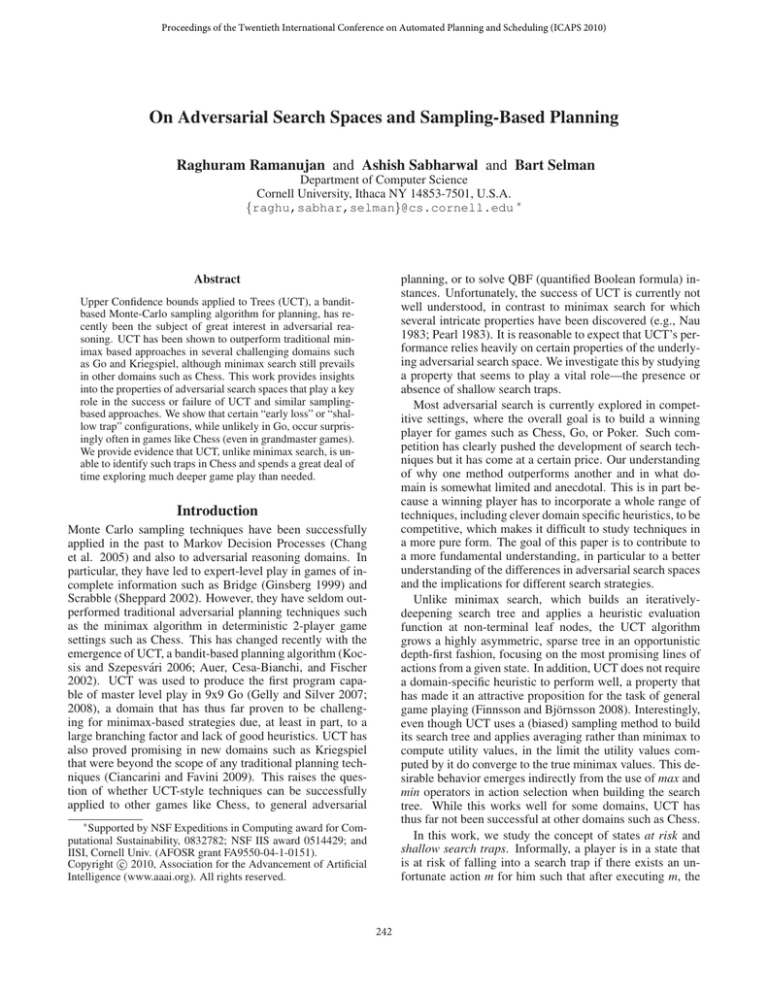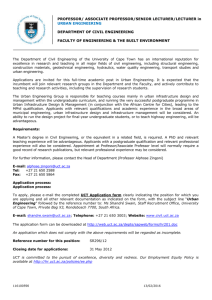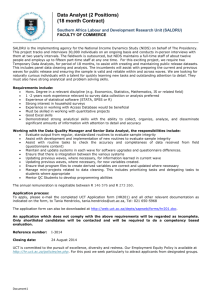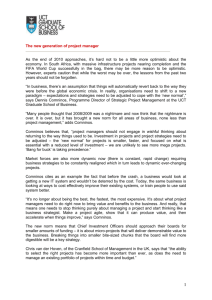
Proceedings of the Twentieth International Conference on Automated Planning and Scheduling (ICAPS 2010)
On Adversarial Search Spaces and Sampling-Based Planning
Raghuram Ramanujan and Ashish Sabharwal and Bart Selman
Department of Computer Science
Cornell University, Ithaca NY 14853-7501, U.S.A.
{raghu,sabhar,selman}@cs.cornell.edu ∗
planning, or to solve QBF (quantified Boolean formula) instances. Unfortunately, the success of UCT is currently not
well understood, in contrast to minimax search for which
several intricate properties have been discovered (e.g., Nau
1983; Pearl 1983). It is reasonable to expect that UCT’s performance relies heavily on certain properties of the underlying adversarial search space. We investigate this by studying
a property that seems to play a vital role—the presence or
absence of shallow search traps.
Most adversarial search is currently explored in competitive settings, where the overall goal is to build a winning
player for games such as Chess, Go, or Poker. Such competition has clearly pushed the development of search techniques but it has come at a certain price. Our understanding
of why one method outperforms another and in what domain is somewhat limited and anecdotal. This is in part because a winning player has to incorporate a whole range of
techniques, including clever domain specific heuristics, to be
competitive, which makes it difficult to study techniques in
a more pure form. The goal of this paper is to contribute to
a more fundamental understanding, in particular to a better
understanding of the differences in adversarial search spaces
and the implications for different search strategies.
Unlike minimax search, which builds an iterativelydeepening search tree and applies a heuristic evaluation
function at non-terminal leaf nodes, the UCT algorithm
grows a highly asymmetric, sparse tree in an opportunistic
depth-first fashion, focusing on the most promising lines of
actions from a given state. In addition, UCT does not require
a domain-specific heuristic to perform well, a property that
has made it an attractive proposition for the task of general
game playing (Finnsson and Björnsson 2008). Interestingly,
even though UCT uses a (biased) sampling method to build
its search tree and applies averaging rather than minimax to
compute utility values, in the limit the utility values computed by it do converge to the true minimax values. This desirable behavior emerges indirectly from the use of max and
min operators in action selection when building the search
tree. While this works well for some domains, UCT has
thus far not been successful at other domains such as Chess.
In this work, we study the concept of states at risk and
shallow search traps. Informally, a player is in a state that
is at risk of falling into a search trap if there exists an unfortunate action m for him such that after executing m, the
Abstract
Upper Confidence bounds applied to Trees (UCT), a banditbased Monte-Carlo sampling algorithm for planning, has recently been the subject of great interest in adversarial reasoning. UCT has been shown to outperform traditional minimax based approaches in several challenging domains such
as Go and Kriegspiel, although minimax search still prevails
in other domains such as Chess. This work provides insights
into the properties of adversarial search spaces that play a key
role in the success or failure of UCT and similar samplingbased approaches. We show that certain “early loss” or “shallow trap” configurations, while unlikely in Go, occur surprisingly often in games like Chess (even in grandmaster games).
We provide evidence that UCT, unlike minimax search, is unable to identify such traps in Chess and spends a great deal of
time exploring much deeper game play than needed.
Introduction
Monte Carlo sampling techniques have been successfully
applied in the past to Markov Decision Processes (Chang
et al. 2005) and also to adversarial reasoning domains. In
particular, they have led to expert-level play in games of incomplete information such as Bridge (Ginsberg 1999) and
Scrabble (Sheppard 2002). However, they have seldom outperformed traditional adversarial planning techniques such
as the minimax algorithm in deterministic 2-player game
settings such as Chess. This has changed recently with the
emergence of UCT, a bandit-based planning algorithm (Kocsis and Szepesvári 2006; Auer, Cesa-Bianchi, and Fischer
2002). UCT was used to produce the first program capable of master level play in 9x9 Go (Gelly and Silver 2007;
2008), a domain that has thus far proven to be challenging for minimax-based strategies due, at least in part, to a
large branching factor and lack of good heuristics. UCT has
also proved promising in new domains such as Kriegspiel
that were beyond the scope of any traditional planning techniques (Ciancarini and Favini 2009). This raises the question of whether UCT-style techniques can be successfully
applied to other games like Chess, to general adversarial
∗ Supported
by NSF Expeditions in Computing award for Computational Sustainability, 0832782; NSF IIS award 0514429; and
IISI, Cornell Univ. (AFOSR grant FA9550-04-1-0151).
c 2010, Association for the Advancement of Artificial
Copyright Intelligence (www.aaai.org). All rights reserved.
242
White player “at risk”
a level-3 trap
for White
guaranteed win for Black
Figure 1: A level-3 search trap for the White player. The
shaded square boxes at the leaves denote terminal nodes indicating a win for Black.
opponent has a guaranteed winning strategy (with optimal
play). We will call the state after executing m a trap. We
found that such traps—even at depths as low as 3 to 7—exist
in interesting Chess positions, at various depths of play.
When traps occur at all depths, the best way of detecting and avoiding them appears to be an iterative deepening
minimax style search. With UCT, even though it converges
to minimax values in the limit, it turns out that it can recognize traps in Chess at level 3 but is likely to miss traps
at levels 5 and higher. Specifically, our experiments reveal
that the utility assigned by UCT to a trap move is often very
close to the utility assigned by it to the best move. This suggests that even if UCT ranks a trap move somewhat lower
than the best move, in general it has trouble distinguishing
really good moves from really bad moves. Traps sprinkled
throughout the search space at various levels are, of course,
extreme examples of bad moves, and it appears very likely
that UCT will choose perhaps a less extreme bad move (a
“soft trap”) during the full length of the game. This, we believe, is a major reason why minimax based strategies have
been much more successful than UCT in games like Chess,
even though UCT currently clearly dominates computer Go.
Figure 2: Percentage of Chess boards at various plys that
have a shallow trap at level ≤ k. Top: 200 semi-randomly
generated boards. Bottom: 200 actual grandmaster games.
Clearly, a search trap is of concern only when the trap is
actually computationally detectable by the opponent. In the
extreme case, every move will lead to a position where, in
principle, either the current player has a winning strategy,
the opponent has a winning strategy, or there is a draw (if
the game allows draws). However, if the winning strategy
for the opponent is so complex or so deep that he cannot reasonably compute it, then making a move to get to that state
shouldn’t be viewed as falling into a dangerous trap. Therefore, we are interested in traps that are identifiable with a
reasonable amount of computation by the adversary. This is
quantified by the level associated with each trap, indicating
the depth of the opponent’s winning strategy.
We will be interested in relatively shallow search traps,
typically those at levels 3, . . . , 7. Further, a trap will be
of even more interest when avoiding the unfortunate move
associated with the shallow trap can actually lead to a much
deeper game play and perhaps even a winning strategy for
the current player. If the underlying adversarial search space
does have traps of this nature, then it becomes critical for
the player to identify and avoid such traps. This is where the
difference between exhaustive algorithms such as minimax
and sampling-based algorithms such as UCT comes in—we
demonstrate that UCT-style algorithms have a good chance
of missing even very shallow traps and thus losing the game.
Traps in Adversarial Search Spaces
The question we seek to address is, how often do adversarial
search spaces exhibit traps and how likely is a player to fall
into such a trap? The notion of search traps and states at
risk is illustrated in Figure 1 and a formal definition is given
below. In the rest of this paper, a k-move winning strategy
for a player p means that there exists an action a1 for p such
that for every possible counter-action of the opponent, there
exists an action a2 for p such that for every counter-action of
the opponent, and so on, there exists an action ak for p that
results in a win for p.
Definition 1. In a 2-player game G, the current player p at
state s is said to be at risk if there exists a move m from state
s such that after executing m, the opponent of p has a k-move
winning strategy. The state of the game after executing m is
referred to as a level-k search trap for p.
Existence of Search Traps
At first, it appears that such shallow traps may be quite rare
in interesting games. This seems to indeed be the case for
games such as Go where it is highly unlikely or even im-
243
Estimated action utility
Table 1: UCT utility estimates for best action as per UCT,
best action as per minimax depth-7, and the trap action.
Shown for varying trap depths.
Best action as per UCT
Best action as per MM−7
Trap action
0.05
0
level-1 trap
level-3 trap
level-5 trap
level-7 trap
−0.05
−0.1
UCT-best
−0.083
+0.020
−0.056
+0.011
Minimax-best
−0.092
+0.013
−0.063
+0.009
Trap move
−0.250
−0.012
−0.066
+0.004
−0.15
0
1
2
3
4
5
6
7
Number of iterations
8
9
10
4
x 10
by a minimax search of depth k + 1 starting from the current state. We therefore give UCT an equivalent search time
(measured in terms of the number of nodes processed) and
study its behavior. In all these experiments, the exploration
bias parameter for UCT is fixed at a value of 0.4, for this
was empirically observed to produce the best performance.
Figure 3: Utility estimates of UCT for the most promising
actions (solid red at top and dashed blue) compared with that
of a level-5 trap action (dotted black initially in the middle).
possible to find abrupt endings of games along one line of
play and dozens of moves along a different line of play.
This is often true in games where wins and losses are defined through the notion of overall territory, etc. On the
other hand, in games such as Chess where wins and losses
are defined through the capture of a certain key piece (e.g.,
the King) or, in general, through a property of a very small
part of the whole state, we found that surprisingly shallow
traps exist—not only for artificially created boards but even
in games played by grandmasters.
Figure 2 shows the percentage of Chess boards that were
found to have traps at various levels. For the top plot, we
used 200 games where each move was played randomly with
probability 1/3 and based on the GNU Chess1 heuristic with
probability 2/3. For the bottom plot, we took 200 games that
were actually played by grandmasters.2 In each case, we
played the game to 15-ply, 31-ply, 47-ply, and 63-ply deep,
and then computed whether or not the resulting board had
a trap at levels 1, 3, or 5 (or 7 as well, in the case of semirandomly generated 15-ply or 31-ply boards). The height
of the bars in the plots indicate the percentage of the resulting boards that were found to have fairly shallow traps. For
example, for semi-randomly generated boards that are 31ply deep, roughly 7-10% of the games have a trap at levels
1 through 7. For games that are 47-ply deep, as many as
15% of the games have shallow traps. In games played by
grandmasters, the percentage of traps is lower but still quite
significant—roughly 12% for 47-ply games. This shows
that in games such as Chess, surprisingly shallow traps are
sprinkled throughout the search space, at essentially every
depth of the game. Hence, a good game playing strategy for
such a search space must incorporate the capability to recognize and avoid such traps.
For the first experiment, we consider the utility assigned
by UCT to the action leading to the trap state, and compare
it with the utility assigned by it to both the action UCT considers the best and the action minimax search (of depth 7,
with the GNU Chess heuristic applied at non-terminal leaf
nodes) considers the best. For Chess boards with White as
the current player, the utilities are real numbers in the range
[−1, 1], with +1 indicating a guaranteed win for White (if
played according to a winning strategy) and −1 indicating
a guaranteed loss. In particular, the action a leading to the
trap for Black should have a utility close to −1.
Figure 3 shows the evolution of the utility of these three
actions as a function of the number of iterations of UCT, up
to the first 100,000 iterations. The board under consideration has a level-5 trap. Table 1 gives UCT utility values for
three other boards as well, with traps at levels 1, 3, and 7, respectively. We make two observations from this experiment.
First, the dotted black line, corresponding to the utility assigned to the trap action, is typically far from being assigned
the ideal utility of −1, which is also seen in the table except
for the board with a level-1 trap. Second, for level-5 and
level-7 traps, the UCT utilities for the trap action are very
close to the utilities assigned to the best action (best as seen
by either UCT or minimax), to a point that it is not easy for
the algorithm to distinguish the best action from an action
resulting in a clear loss. As mentioned earlier, this suggests
that UCT will have even more trouble distinguishing “soft
traps” from good moves, and is likely to make moves that
result, for example, in a significant material disadvantage.
One reason that UCT may have assigned a relatively high
utility to the trap state for White (over −0.07 rather than the
ideal −1) is that it simply didn’t visit the trap state enough,
presumably because it did not find the action leading to it to
be a promising enough action. Could the estimate of UCT
get better if it were allowed to have more samples from the
trap state? We again found that this is not the case—even if
UCT is allowed to sample as many as 10 times the number of
nodes minimax needs to visit to identify the trap, the utility
assigned by UCT to the trap state remains high, over −0.15,
Identifying and Avoiding Traps
This section describes our empirical investigation of the
question, can UCT-style algorithms successfully identify and
avoid shallow traps? Clearly, a k-level trap can be identified
1 Source:
2 Source:
http://www.gnu.org/software/chess
http://www.chessgames.com
244
0.3
0.5
0.25
0.45
0.25
0.4
0.2
0.3
0.25
0.2
0.2
Frequency
Frequency
Frequency
0.35
0.15
0.15
0.1
0.1
0.15
0.1
0.05
0.05
0.05
0
0
1
2
0
3
0
Tree Exploration Depth
1
2
3
4
5
6
7
8
9
Tree Exploration Depth
10
11
12
13
0
0
5
10
15
20
Tree Exploration Depth
Figure 4: Histogram of search depths that iterations of UCT explored when in a trap state of depth 3, 5, and 7, respectively.
the presence of a level-3 trap, which it correctly identifies.
In general, the amount of effort UCT spends beyond what
it needs to had it identified the winning strategy, appears to
increase exponentially with trap depth. This demonstrates
that UCT pretty much fails to identify the (shallow) winning
strategy during these search experiments.
Utility Estimate of Best Action
0
−0.2
−0.4
−0.6
−0.8
Conclusion
Level−3 Trap
This work provides new insights into the nature of adversarial search spaces, specifically in terms of the existence (or
non-existence) of shallow traps, which UCT is not good at
identifying. This helps explain the success of UCT in domains such as Go and its limitations in domains such as
Chess. This study also indicates that UCT-style methods
have the potential of enhancing adversarial reasoning systems such as QBF solvers, as long as the domain they operate on does not have traps in the underlying search space.
Level−5 Trap
Level−7 Trap
−1
0
2
4
6
8
(Num UCT iterations) / (Num min−max nodes)
Figure 5: UCT estimate of the trap state stays incorrectly
high, except for the level-3 trap (solid red curve that drops),
even if the trap state is visited 10x times the number of nodes
visited by the minimax search identifying the trap.
References
as long as the trap is at level 5 or higher.3 This is depicted in
Figure 5, which shows the evolution of the utility assigned
by UCT to the trap state if UCT is started at the trap state
itself and thus forced to visit this state in every iteration. For
the level-3 trap (the solid red curve), UCT does identify the
winning strategy and subsequently quickly converges to −1
as in the ideal case. However, for level-5 and level-7 traps,
its utility remains high.
Finally, in order to better understand why UCT does not
assign a utility even remotely close to −1 to trap states at
levels 5 and higher even with 10 times the effort of minimax search (in some cases 50 times the effort; data not presented here), we took a deeper look at the main feature of
UCT, namely, that it searches relatively much deeper into
regions that it thinks are promising. Of course, for a levelk trap, minimax search would identify the level-k winning
strategy and never explore nodes deeper than depth k. On
the other hand, as the center and right-hand-side histograms
in Figure 4 show, UCT spends nearly 70% of the time exploring nodes deeper than level 5 in the presence of a level5 trap, and nearly 95% of the time exploring nodes deeper
than level 7 (as high as level 20) in the presence of a level7 trap. This is in stark contrast to the left hand side plot,
which shows that UCT explores nodes only up to depth 3 in
Auer, P.; Cesa-Bianchi, N.; and Fischer, P. 2002. Finite-time analysis of the multiarmed bandit problem. Machine Learning 47(23):235–256.
Chang, H. S.; Fu, M. C.; Hu, J.; and Marcus, S. I. 2005. An adaptive sampling algorithm for solving Markov decision processes.
Operations Research 53(1):126–139.
Ciancarini, P., and Favini, G. P. 2009. Monte Carlo tree search
techniques in the game of Kriegspiel. In IJCAI-09.
Coulom, R. 2006. Efficient selection and backup operators in
Monte-Carlo tree search. In 5th Intl. Conf. on Computer and
Games, volume 4360 of LNCS, 72–83.
Finnsson, H., and Björnsson, Y. 2008. Simulation-based approach
to general game playing. In AAAI-08, 259–264. AAAI Press.
Gelly, S., and Silver, D. 2007. Combining online and offline knowledge in UCT. In 24th ICML, 273–280.
Gelly, S., and Silver, D. 2008. Achieving master level play in 9 × 9
computer Go. In 23rd AAAI, 1537–1540.
Ginsberg, M. L. 1999. GIB: Steps toward an expert-level bridgeplaying program. In IJCAI-99, 584–589.
Kocsis, L., and Szepesvári, C. 2006. Bandit based Monte-Carlo
planning. In 17th ECML, volume 4212 of LNCS, 282–293.
Nau, D. S. 1983. Pathology on game trees revisited, and an alternative to minimaxing. Artif. Intell. 21(1-2):221–244.
Pearl, J. 1983. On the nature of pathology in game searching. Artif.
Intell. 20(4):427–453.
Sheppard, B. 2002. World-championship-caliber Scrabble. Artif.
Intell. 134(1-2):241–275.
3 For
level-7 traps, UCT did find the trap in some runs after
around 5 times the effort of minimax search; nevertheless, it failed
on several runs and risked the chance of falling into a trap.
245









